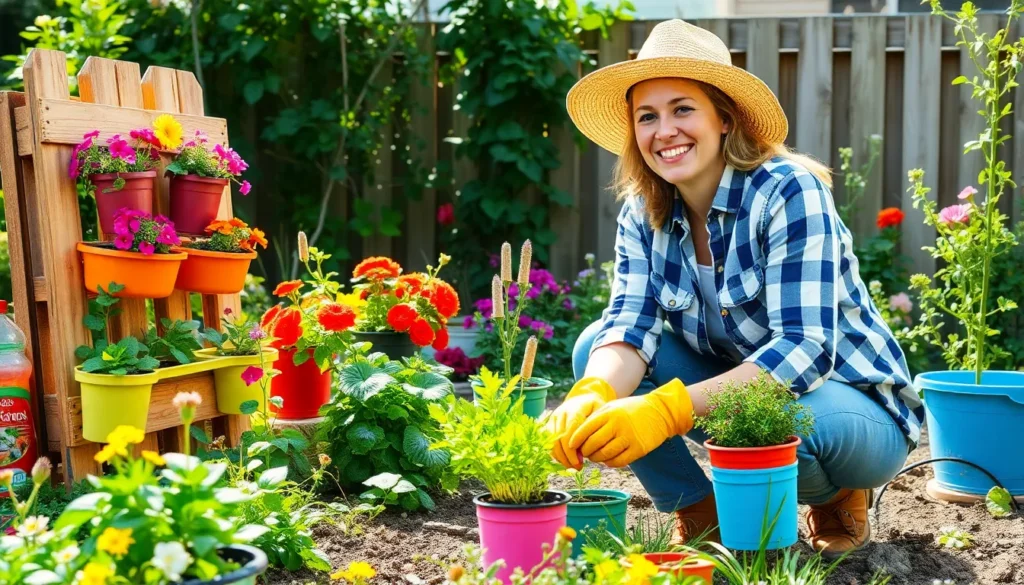We’ve all dreamed of having that perfect garden – the kind that makes neighbors peek over the fence with envy. But here’s the thing: you don’t need a massive budget or professional landscaping crew to transform your outdoor space into something spectacular.
DIY garden projects are taking over backyards everywhere and for good reason. They’re budget-friendly cost-effective and incredibly rewarding. Whether you’re working with a sprawling yard or a tiny balcony we’ll show you how to create stunning garden features that’ll have everyone asking “did you really make that yourself?”
From vertical planters that maximize small spaces to elegant water features that add tranquil vibes – we’ve gathered the most creative and achievable DIY garden ideas. These projects won’t just save you money; they’ll give your garden that unique personal touch that no store-bought solution can match.
Create a Vertical Garden Using Recycled Materials
Transform your outdoor space by repurposing everyday materials into stunning vertical gardens. We’ll show you how to build impressive green walls using items you likely already have around your home.
Building a Pallet Planter Wall
Pallets make exceptional vertical garden foundations when properly prepared and positioned. Start by sanding down a wooden pallet and applying a food safe wood sealant to protect against moisture damage. Attach industry fabric to the back and bottom slats using a heavy duty stapler to create planting pockets.
Fill each section with high quality potting mix and plant your chosen herbs vegetables or flowers directly into the openings. Mount the completed pallet against a sturdy fence or wall using metal brackets that can support the additional weight of soil and water. This design typically accommodates 6 to 8 plants depending on the pallet size.
Water your pallet garden slowly from the top allowing moisture to trickle down through each level. The vertical structure saves up to 75% of traditional garden space while providing excellent drainage for most plant varieties.
Constructing Hanging Bottle Gardens
Plastic bottles become productive hanging planters with minimal preparation and creative positioning. Cut 2 liter bottles in half and poke drainage holes in the bottom portion using a heated nail or small drill bit. Thread strong rope or wire through holes near the rim to create hanging loops.
Add gravel to the bottom inch for proper drainage then fill with lightweight potting soil mixed with perlite. Plant herbs like basil thyme or mint which thrive in contained spaces and don’t require deep root systems. Hang these bottle gardens at varying heights to create visual interest and maximize growing space.
Group 5 to 7 bottle planters together for maximum impact and easier watering maintenance. This method costs under $10 to create while recycling materials that would otherwise end up in landfills.
Designing a Ladder Herb Garden
Old wooden ladders provide perfect multi level growing platforms when converted into herb garden displays. Position the ladder against a wall or fence for stability and place potted herbs on each rung at different heights. This arrangement creates natural tiers that make harvesting and maintenance incredibly convenient.
Choose pots that match the width of your ladder rungs and secure them with small brackets if needed for windy locations. Plant frequently used culinary herbs like rosemary oregano and sage on lower rungs for easy access during cooking. Reserve upper levels for decorative herbs or those requiring more sunlight exposure.
Paint the ladder with weather resistant stain to match your garden aesthetic and extend its lifespan by several years. Each ladder typically holds 8 to 12 herb pots depending on its height and your container sizes.
Build Raised Garden Beds on a Budget
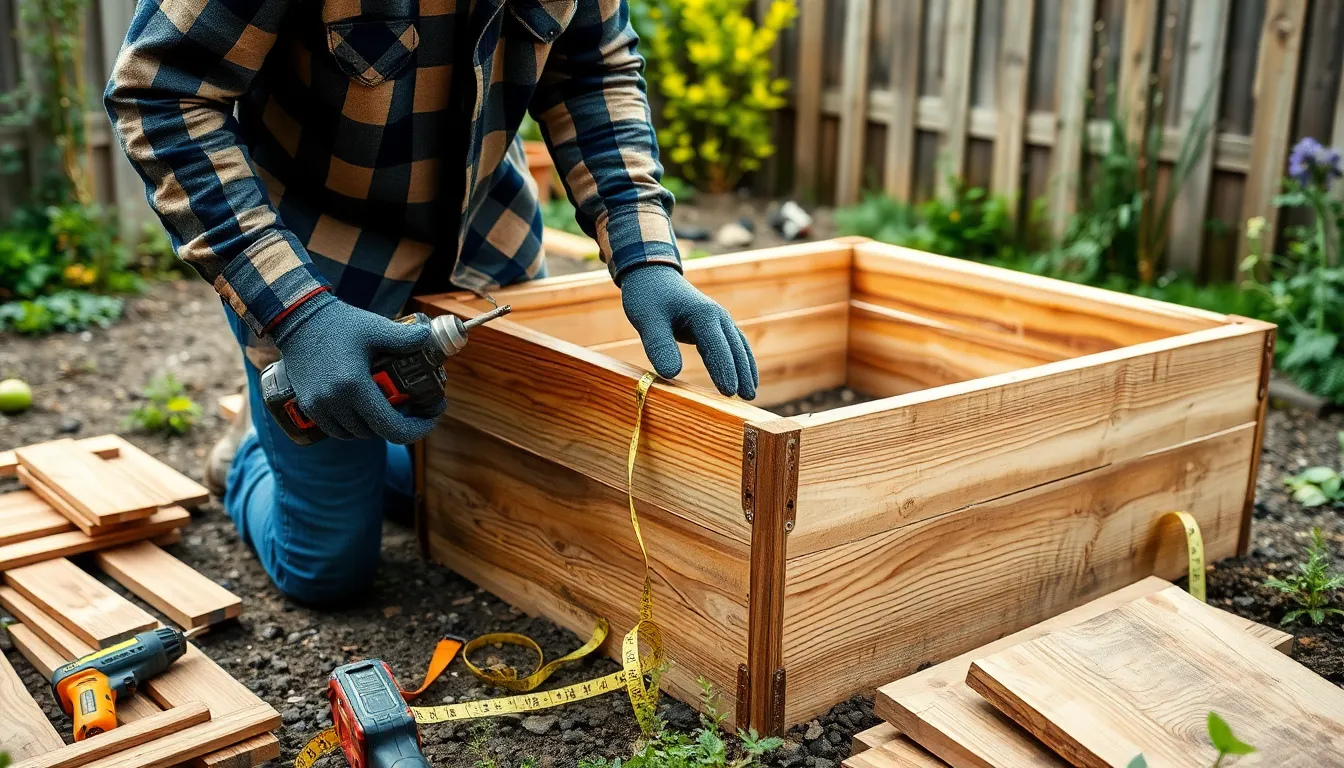
Building raised garden beds doesn’t have to expensive when we use smart material choices and creative construction methods. We’ll explore three cost-effective approaches that deliver professional results without the premium price tag.
Using Reclaimed Wood for Garden Boxes
Reclaimed wood offers us an eco-friendly solution that adds rustic charm while keeping costs minimal. We can source these materials from old pallets, fence boards, or construction sites for a fraction of new lumber prices.
Materials we’ll need:
- Reclaimed wood planks
- Wood screws
- Power drill
- Measuring tape
Building our wooden garden box starts with cutting the reclaimed planks to our desired dimensions. We’ll assemble the frame using wood screws at each corner, ensuring tight joints for stability. Adding a bottom panel prevents soil spillage and creates a complete growing environment for our plants.
Pallet garden beds represent another budget-friendly option using reclaimed materials. We can transform old shipping pallets into functional raised beds using basic tools and minimal additional lumber. This method typically costs under $20 per bed and can be completed in just a few hours.
Creating Stone and Brick Raised Beds
Stone and brick construction provides us with durable, long-lasting garden beds that improve with age. We can often find these materials at salvage yards or construction sites for significantly less than retail prices.
Essential materials include:
- Stones or reclaimed bricks
- Sand or gravel for base preparation
- Mortar (optional for permanent installation)
- Level and measuring tools
Preparing our foundation begins with laying a sand or gravel base for proper drainage and stability. We’ll arrange the stones or bricks in our desired pattern, stacking them to create walls of appropriate height. Using mortar secures permanent installations, though dry-stacking allows for future modifications and easier relocation.
These natural materials blend seamlessly with existing industry features while providing excellent thermal mass for plant roots. We can expect stone and brick beds to last decades with minimal maintenance requirements.
Constructing Galvanized Steel Planters
Galvanized steel planters combine modern aesthetics with practical durability at reasonable costs. We can purchase steel sheets from metal supply stores and fabricate custom planters to fit exact spaces and design requirements.
Required materials include:
- Galvanized steel sheets
- Metal cutting tools or saw
- Drill with metal bits
- Screws or rivets for assembly
Cutting our steel sheets to size requires careful measurement and proper safety equipment. We’ll assemble the planter walls using screws or rivets, creating clean joints that resist weather and corrosion. Adding drainage holes prevents waterlogging and ensures healthy root development for our plants.
Steel planters heat up quickly in spring, extending our growing season naturally. We can customize dimensions to fit narrow spaces or create modular systems that adapt to changing garden layouts over time.
Design a DIY Water Feature for Your Garden
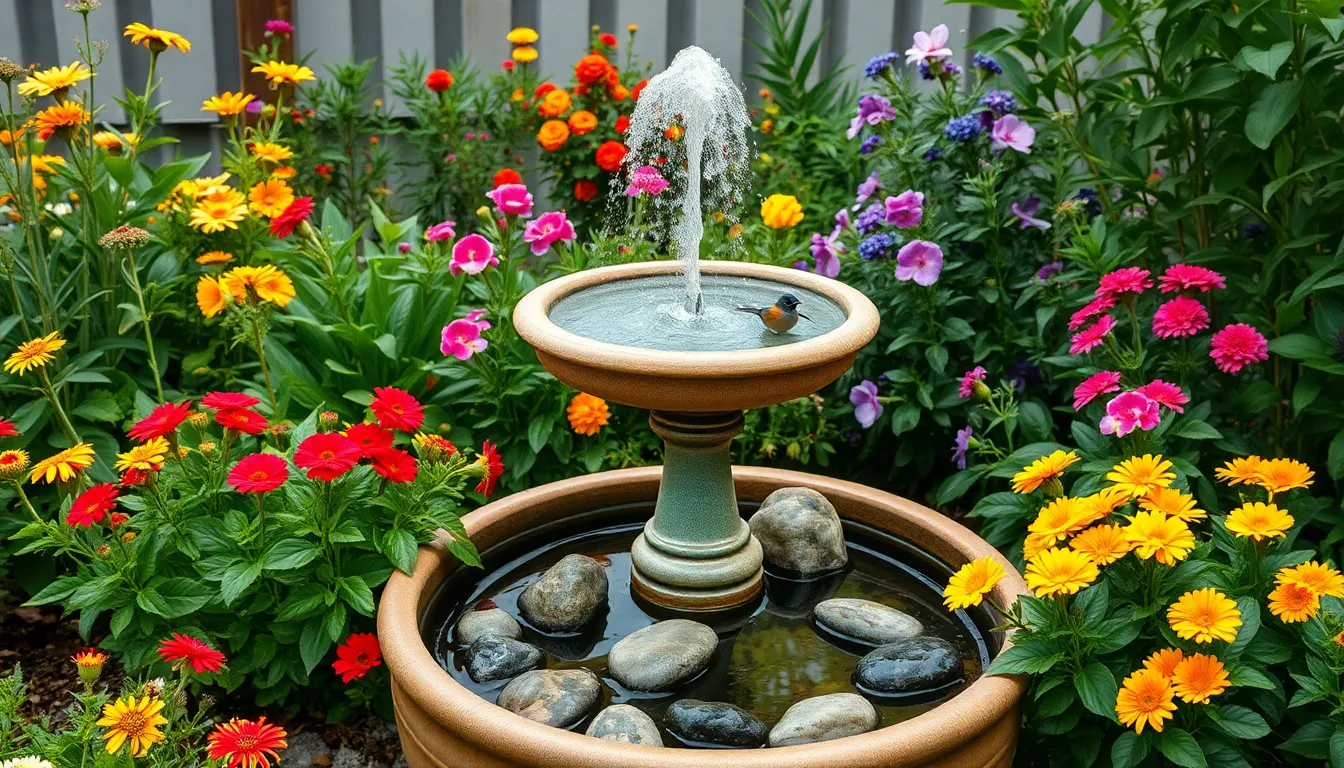
Water features bring instant tranquility to any outdoor space while creating a focal point that enhances your garden’s natural beauty. We’ll show you how to build stunning water features using affordable materials and simple techniques.
Installing a Simple Fountain System
Solar fountain kits transform basic birdbaths into ever-changing water features with minimal investment. We recommend starting with a solar fountain water pump kit that requires no electrical wiring and operates entirely on sunlight. Position the solar panel in a sunny location and connect it to the submersible pump placed in your birdbath or container.
Three-tiered bird baths create impressive fountain systems that attract wildlife while adding vertical interest to your space. Stack graduated-size basins with a central pump system that circulates water from the bottom tier to the top. This design provides multiple water levels for different bird species and creates pleasant trickling sounds throughout your garden.
Tea pot fountains offer charming rustic appeal using an iron tea pot and whiskey barrel combination. Install a small pump in the barrel that circulates water up through tubing into the tea pot spout. The water then flows back into the barrel creating a continuous cycle that adds both visual and auditory appeal to your garden design.
Building a Rain Chain Water Feature
Hanging metal chains replace traditional downspouts while creating mesmerizing water displays during rainfall. Attach a decorative chain or series of metal cups to your gutter system allowing rainwater to flow down each piece. This creates a soothing cascade effect that transforms ordinary storms into garden entertainment.
Wood and metal combinations provide unique aesthetic options for rain chain installations. Connect alternating wooden discs and metal elements to create varied water flow patterns. The different materials produce distinct sounds as water moves from piece to piece creating a natural percussion system for your outdoor space.
Ground basins collect rainwater at the base of your rain chain preventing erosion while creating temporary water features. Position decorative stones or a small container beneath the chain to catch flowing water. This setup doubles as both functional drainage and an attractive garden element during dry periods.
Creating a Pond Using a Large Container
Large tubs and containers serve as instant pond foundations without expensive excavation or professional installation. We suggest using galvanized tubs or large ceramic pots that hold at least 20 gallons of water. These containers provide sufficient depth for aquatic plants while remaining manageable for DIY installation and maintenance.
Pump systems and plants transform static containers into thriving aquatic ecosystems. Install a small submersible pump to create water movement that prevents stagnation and supports plant health. Add floating plants like water lilies and submerged oxygenating plants to maintain water quality naturally.
Decorative rock arrangements enhance container ponds with natural beauty and functional benefits. Stack stones around the container edges to hide the rim and create graduated levels for plant placement. These rocks also provide landing spots for wildlife and help integrate your water feature seamlessly into the surrounding garden industry.
Establish Natural Pest Control Solutions
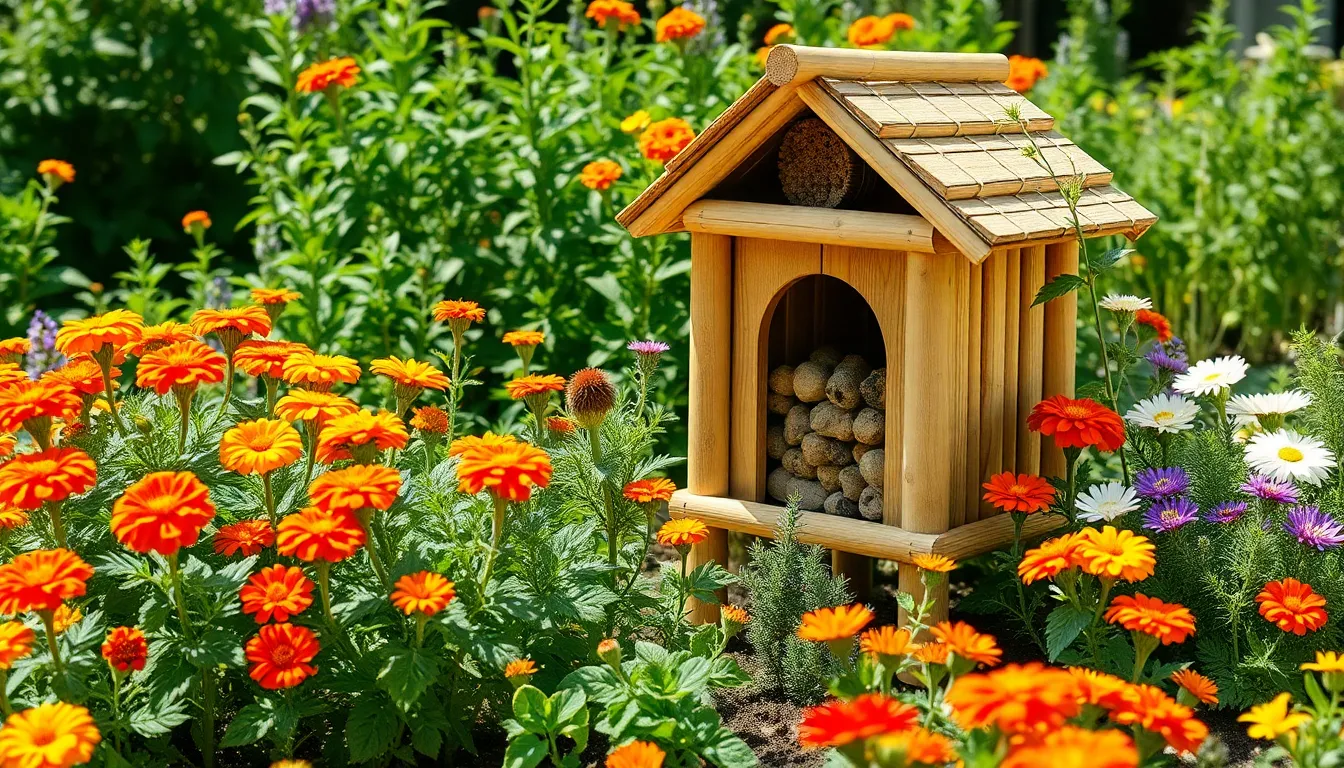
Protecting our gardens doesn’t require harsh chemicals when we embrace nature’s own defense systems. We’ll create sustainable pest management strategies that work with our garden’s network rather than against it.
Planting Companion Plants for Pest Management
Strategic companion planting transforms our gardens into natural pest deterrent zones. Mint planted around garden beds effectively repels aphids while creating aromatic borders that enhance our outdoor spaces. Basil keeps flies away from vegetable gardens and adds culinary value to our harvests.
Marigolds serve as powerful pest fighters by releasing compounds that deter nematodes and other harmful insects. We can interplant these vibrant flowers throughout our vegetable rows for maximum protection. Nasturtiums act as trap crops for aphids and cucumber beetles while providing edible flowers for our kitchen table.
Herbs like rosemary and thyme create natural barriers against cabbage moths and carrot flies. Planting these aromatic companions near susceptible vegetables creates protective zones that pests actively avoid.
Building Beneficial Insect Hotels
Constructing insect hotels provides shelter for beneficial predators that naturally control pest populations. We can use bamboo tubes of varying diameters to attract different species of beneficial insects to our gardens. Drilling holes in untreated wood blocks creates nesting sites for solitary bees that pollinate our plants.
Layering different materials like pine cones, bark, and hollow stems accommodates diverse beneficial insects with varying habitat needs. Positioning these hotels in sunny, protected locations near flowering plants ensures maximum occupancy rates. We’ll mount them 3 to 6 feet above ground level for optimal accessibility to helpful insects.
Bundle materials tightly to prevent moisture buildup that could harm beneficial insects during winter months. Creating multiple smaller hotels throughout our garden provides better coverage than one large structure.
Creating Homemade Organic Sprays
Mixing homemade sprays gives us effective pest control without synthetic chemicals. Soap spray combines 1.5 teaspoons of mild liquid soap with one quart of water to control spider mites and aphids naturally. We’ll apply this solution during cooler parts of the day to prevent leaf burn.
Cayenne pepper spray blends onion, garlic, peppermint, cayenne pepper, and soap in water for potent pest deterrence. This mixture effectively repels soft-bodied insects while being safe for beneficial pollinators when applied correctly.
Chili spray mixes chili powder with water and mild soap to create a barrier against various garden pests. We can strain this mixture through cheesecloth to prevent nozzle clogging in our spray bottles.
Neem oil disrupts insect life cycles and proves particularly effective against aphids and Japanese beetles. Diluting neem oil according to package directions creates a systemic treatment that protects plants for extended periods.
Construct Creative Plant Containers and Planters
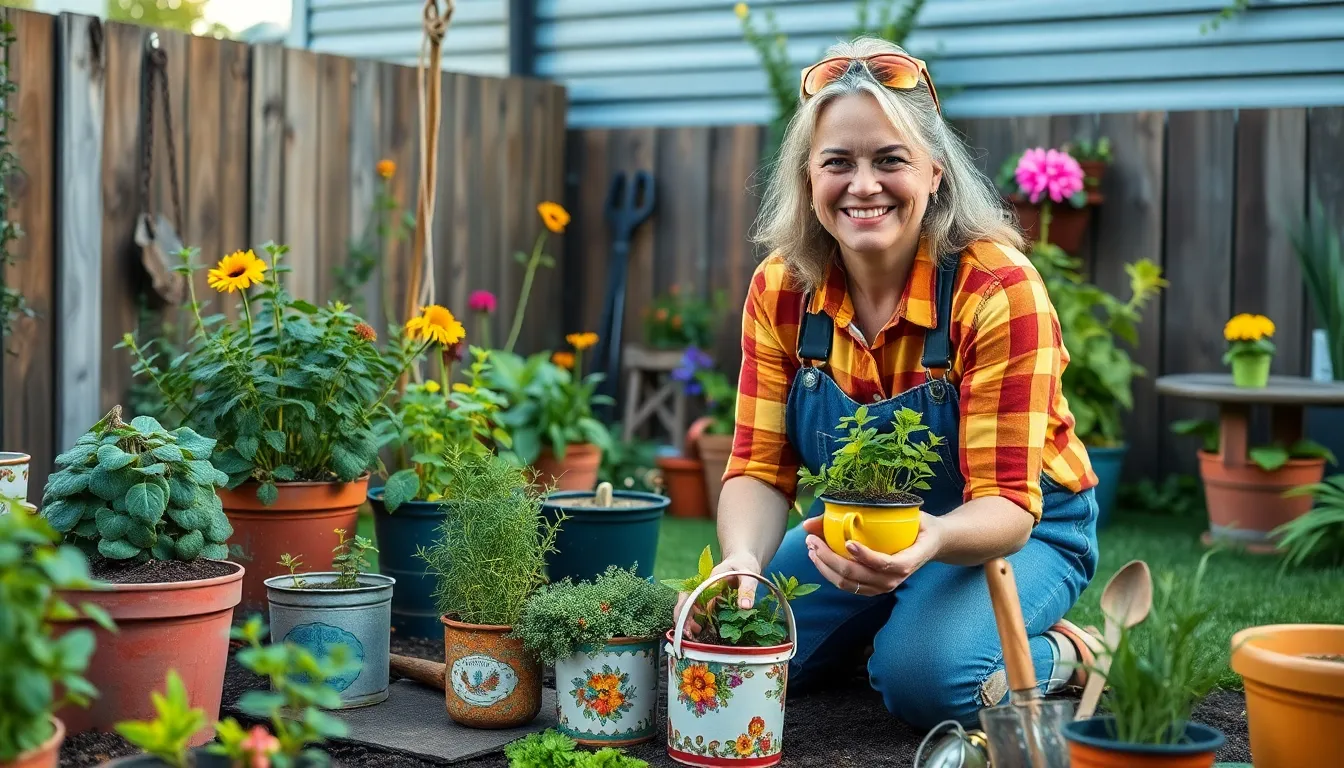
We’re transforming ordinary household objects into extraordinary planters that’ll give our gardens personality without very costly. These DIY container projects let us express creativity while solving practical gardening needs.
Repurposing Household Items as Planters
Tin cans become charming mini planters when we punch drainage holes and remove sharp edges. We can paint these containers in vibrant colors or wrap them with twine for a rustic aesthetic. Tea cups and old boots make delightful conversation pieces when filled with succulents or small herbs.
Large galvanized tubs and vintage bathtubs create impressive statement planters for our bigger plants. Old toolboxes and petrol cans add industrial charm to modern garden designs while providing ample growing space.
Plastic food containers work perfectly as budget friendly planters when we drill drainage holes at the bottom. We’ll paint these containers to match our garden’s color scheme and use them to collect excess water that might otherwise create puddles.
Bathroom light fixtures transform into unique hanging planters with minimal modification. These repurposed fixtures add vertical interest to our garden spaces while giving new life to discarded items.
Building Custom Wooden Planters
Untreated wood gives us complete control over planter dimensions and design aesthetics. We’ll measure our space carefully and cut boards to create boxes that fit perfectly in our designated areas. Cedar and redwood resist rot naturally, making them excellent choices for long lasting containers.
Drainage holes become critical for plant health, so we’ll drill several quarter inch holes across the bottom surface. We can line the interior with industry fabric to prevent soil from washing through while maintaining proper water flow.
Paint or wood stain allows us to customize our planters to complement existing garden decor. We’ll apply a weatherproof finish to protect the wood from moisture and extend the planter’s lifespan significantly.
Creating Concrete and Hypertufa Containers
Concrete planters offer exceptional durability when we mix cement with sand and pea gravel aggregates. We’ll use cardboard boxes or plastic containers as molds to shape our planters into desired forms. These heavy containers work perfectly for large plants that might tip over in lighter containers.
Hypertufa creates lighter alternatives by combining one part cement, one part peat moss, and one part perlite. This mixture produces porous containers that breathe better than solid concrete while maintaining strength and weather resistance.
Molds determine our final container shape, so we’ll choose forms that match our garden’s style. We can create drainage holes by inserting dowels before the mixture sets, then removing them once the material begins to harden.
Install Efficient DIY Irrigation Systems
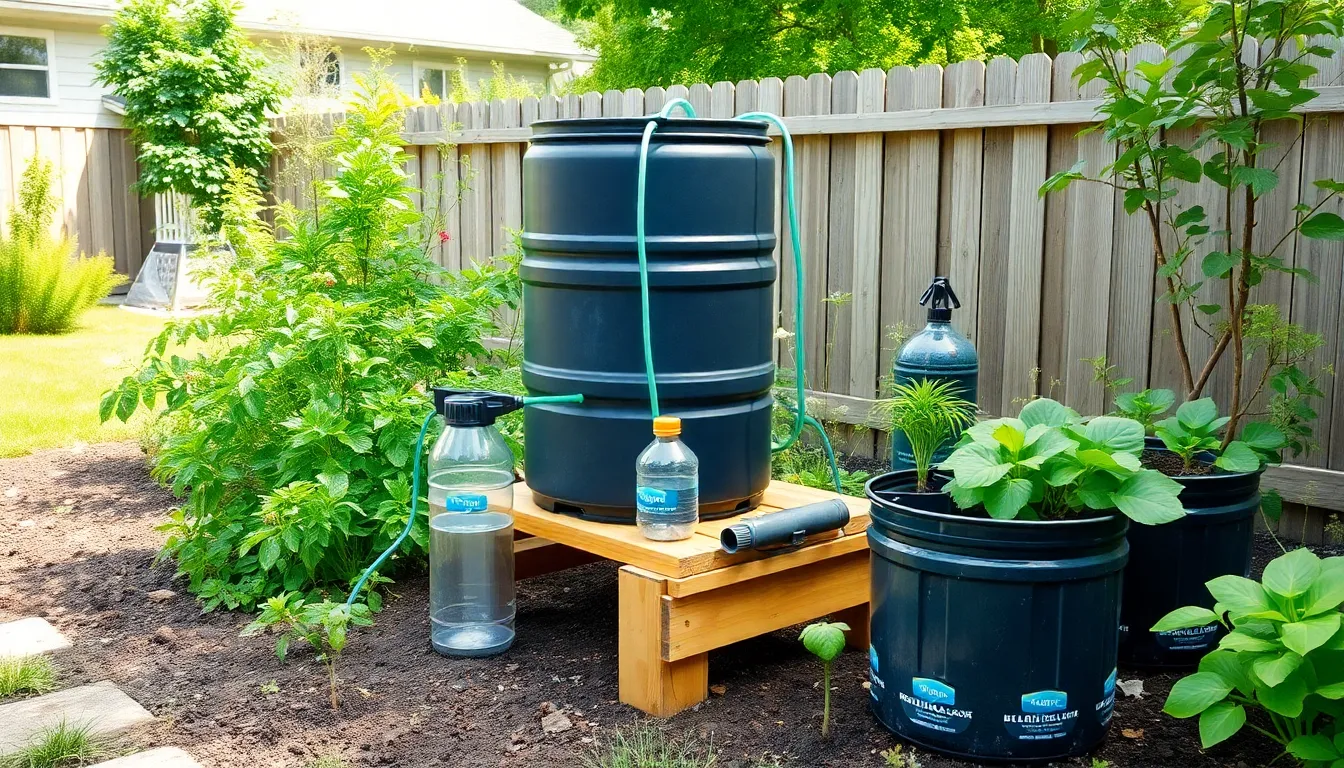
Smart irrigation systems transform our gardening experience by delivering water directly where plants need it most. Efficient watering methods reduce our water bills while keeping plants healthier than traditional sprinkler systems.
Setting Up Drip Irrigation with Plastic Bottles
Plastic bottles create the most cost effective mini irrigation reservoirs for targeted plant watering. We’ll need plastic bottles of various sizes, a drill with small bits, and flexible tubing to connect our system.
Materials and Setup Process:
- Drill small holes in bottle bottoms using a 1/8 inch bit
- Position bottles near plant root zones for maximum efficiency
- Connect bottles using 1/4 inch flexible tubing for continuous flow
- Fill bottles with water and monitor drainage rates daily
System Benefits:
- Costs under $10 for materials covering 20 plant stations
- Reduces water waste by 40% compared to overhead watering
- Provides consistent moisture levels plants prefer
- Requires refilling bottles only twice weekly during peak growing season
Building a Rain Barrel Collection System
Rain barrels capture free water from our roof runoff while reducing stormwater pollution. Standard 55 gallon food grade barrels work best for most residential collection needs.
Essential Components:
- Food grade barrel with tight fitting lid
- Downspout diverter kit ($15-25 at hardware stores)
- Overflow valve positioned 2 inches from barrel top
- Spigot installed 4 inches above ground level
Installation Steps:
- Position barrel on stable concrete blocks or wooden platform
- Attach downspout diverter following manufacturer instructions
- Install overflow valve to prevent water damage during heavy rains
- Connect spigot using rubber gaskets for leak proof seal
Rain collection systems provide 600 gallons of water annually per inch of rainfall on a 1,000 square foot roof area.
Creating Self-Watering Planters
Self watering planters maintain consistent soil moisture without daily attention from busy gardeners. These systems use water reservoirs and wicking materials to deliver moisture as plants need it.
Container Setup:
- Choose planters with built in water chambers or create reservoirs using plastic containers
- Add absorbent materials like coconut coir or vermiculite to potting mix
- Install water level indicators to monitor reservoir status
- Position wicking materials to connect soil with water source
Planting and Maintenance:
- Fill reservoirs through designated filling tubes
- Plant directly into moisture controlled growing medium
- Check water levels weekly during active growing periods
- Refill reservoirs when indicators show low water status
Self watering systems reduce watering frequency by 60% while maintaining optimal plant hydration levels throughout growing seasons.
Build Garden Structures and Support Systems
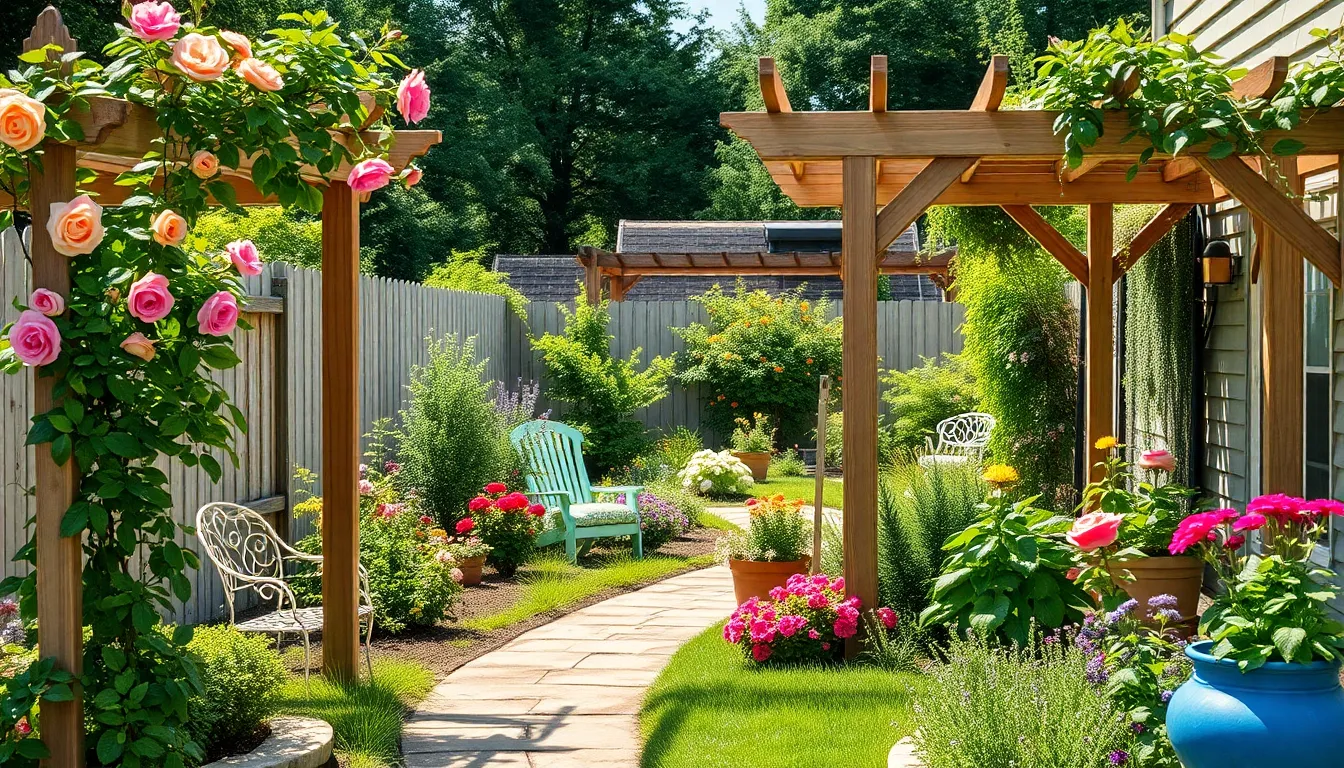
Strong garden frameworks create the backbone of any successful outdoor space. We’ll explore essential structures that provide both functionality and visual appeal to transform your garden into an organized paradise.
Constructing Trellises and Arbors
Simple frame trellises offer the most cost-effective way to support climbing plants and herbs. We can construct these structures using basic wood frames and adding sturdy hooks for hanging buckets, creating perfect growing stations for herbs and small plants. This design accommodates multiple growing containers while maximizing vertical space in compact gardens.
Garden arbors provide essential shade while supporting vigorous climbing plants like roses, clematis, and grape vines. Installing these structures creates natural focal points that define garden spaces and establish clear pathways. We recommend positioning arbors at garden entrances or along walkways to create dramatic visual transitions.
Decorative arbor combinations elevate standard structures into artistic garden features. Building arbors with succulent bird houses adds whimsical charm while serving dual purposes for both plants and wildlife. The succulent roof design creates a living canopy that changes seasonally, providing year-round visual interest.
Building Garden Pathways and Stepping Stones
Paver flooring systems transform greenhouse areas and garden sections into professional-looking spaces. We can install these surfaces in greenhouses or outdoor garden rooms, then apply decorative stenciling for personalized patterns. This approach creates durable walkways that withstand weather while adding sophisticated design elements to utilitarian spaces.
Natural stone walkways guide visitors through garden areas while protecting plant beds from foot traffic. Creating these pathways using locally sourced stones or gravel establishes clear navigation routes that complement existing landscaping. We position these walkways to showcase garden highlights while providing practical access to maintenance areas.
Mixed material paths combine different textures and colors for ever-changing visual effects. Alternating between stone sections and gravel areas creates rhythm and prevents monotonous designs. These combinations work especially well in larger gardens where longer pathways need visual breaks to maintain interest.
Creating Storage Answers and Tool Organizers
Pallet tool racks repurpose discarded materials into functional storage systems for garden equipment. We can transform old pallets into organized storage for rakes, shovels, and long-handled tools by adding hooks and brackets. This solution keeps tools accessible while protecting them from weather damage and ground moisture.
Portable planter systems with casters provide flexible growing options for deck and patio gardens. Building these mobile containers allows us to move plants to optimize sun exposure throughout growing seasons. We recommend adding locking wheels to prevent unwanted movement while maintaining easy repositioning capabilities.
Fairy garden containers repurpose broken pots into enchanting miniature landscapes. Creating these whimsical displays from damaged pottery adds magical elements to yards while recycling materials that would otherwise be discarded. We can build multi-level fairy gardens using various sized pot fragments to create terraced growing areas for tiny plants and decorative elements.
Establish a Composting System in Your Backyard
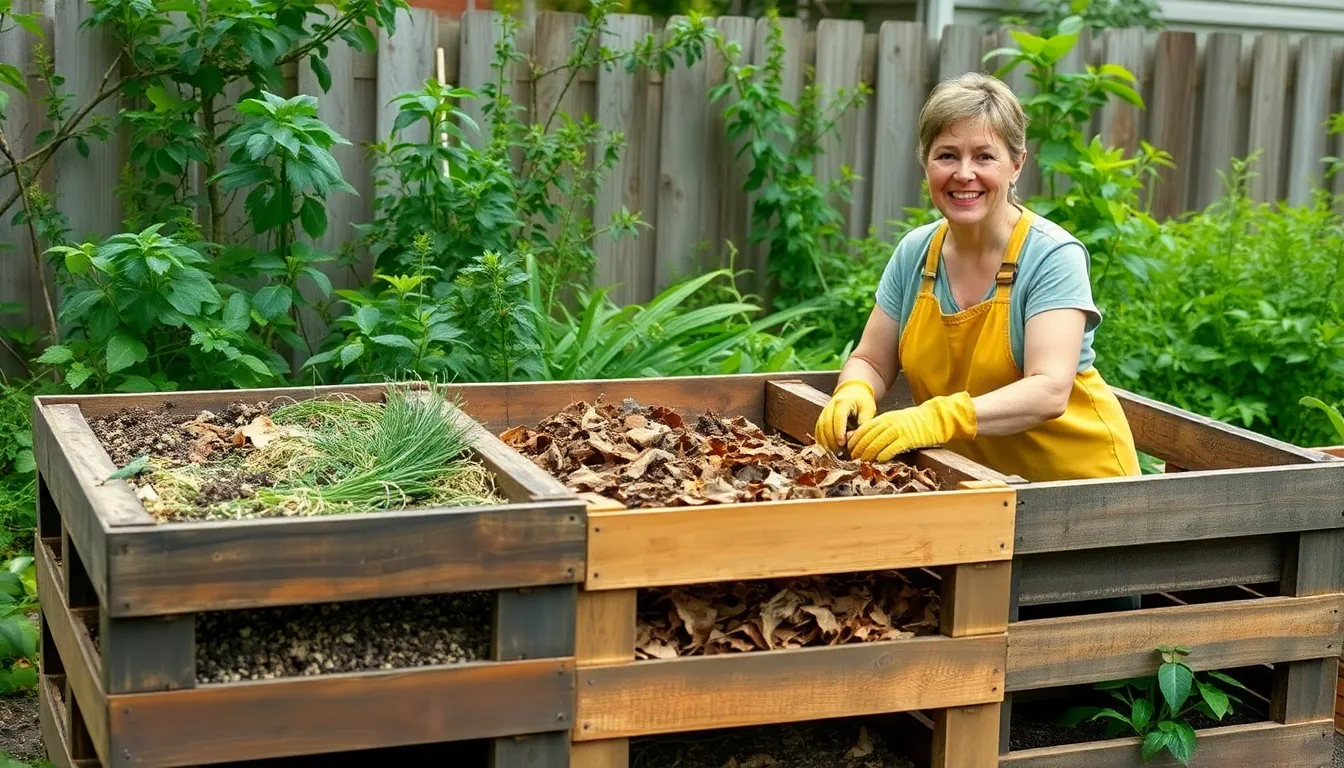
Transforming kitchen scraps and yard waste into nutrient-rich soil becomes effortless with our proven composting methods. We’ll show you three effective systems that turn organic waste into garden gold while reducing household garbage by up to 30%.
Building a Three-Bin Composting System
Constructing a three-bin system gives us the most efficient composting setup for serious gardeners. We recommend using wooden pallets or wire fencing to create three separate 3×3 foot compartments that serve distinct purposes throughout the composting cycle.
Each bin handles a different composting stage to ensure continuous production of finished compost. We fill the first bin with fresh materials like food scraps and lawn clippings mixed with brown materials such as leaves and wood chips. Our second bin receives partially decomposed materials for turning and aeration. The third compartment stores finished compost that’s ready for garden use.
Benefits of this system include consistent compost production and simplified material management. We can harvest finished compost from one bin while actively composting in the other two. This method produces approximately 20-30 cubic feet of finished compost annually from average household waste.
Creating a Tumbling Composter
Building a tumbling composter accelerates decomposition through regular rotation and improved aeration. We use a plastic or metal drum with multiple ventilation holes drilled throughout the surface for optimal airflow.
Materials needed include a 55-gallon drum, metal rod for the axle, and a simple frame to support rotation. We fill the drum with alternating layers of brown materials like straw and green materials such as vegetable scraps. Regular turning every 2-3 days speeds up the composting process significantly.
Advantages of tumbling composters include faster processing times and space efficiency for smaller gardens. We typically see finished compost in 6-8 weeks compared to 6-12 months with traditional pile methods. These compact units work perfectly for urban gardeners with limited space.
Setting Up Worm Composting Bins
Creating a worm composting system brings efficient decomposition indoors or to covered outdoor areas. We need a plastic bin with lid, bedding material like shredded newspaper, red wiggler worms, and regular food scraps for feeding.
Setting up requires drilling air holes around the upper portion and drainage holes in the bottom for proper ventilation. We layer shredded paper bedding, add approximately 1 pound of red wiggler worms, and begin feeding with small amounts of fruit and vegetable scraps. Maintaining proper moisture levels keeps the system odor-free and productive.
Benefits include year-round composting capability and production of high-quality vermicompost that’s richer in nutrients than traditional compost. We harvest finished worm castings every 3-4 months, producing about 10 pounds of premium soil amendment from a standard 18-gallon bin system.
Design Decorative Garden Elements and Lighting
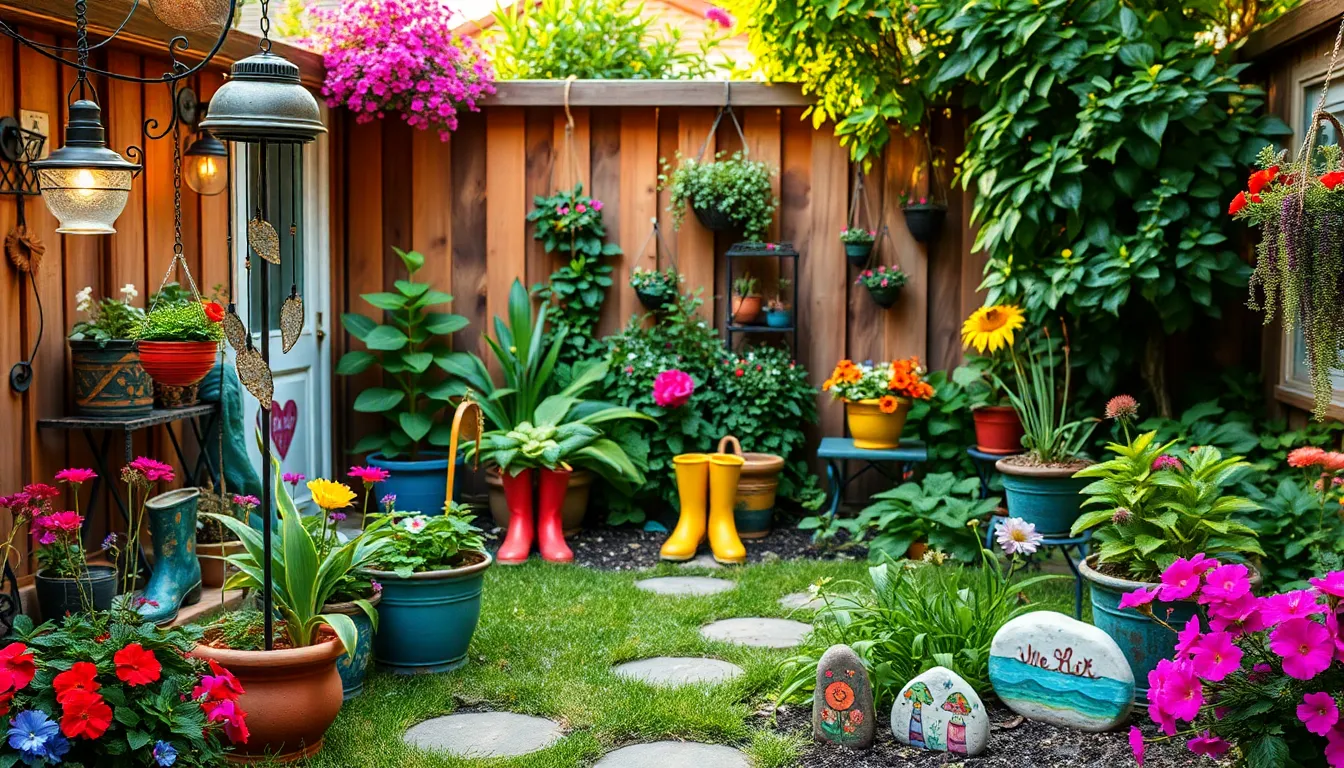
Beautiful garden spaces need more than just plants to create truly memorable experiences. We’ll explore creative ways to add personality and illumination to outdoor areas using sustainable materials and innovative lighting answers.
Making Garden Art from Recycled Materials
Repurposed household items become stunning garden art pieces that add character without breaking our budget. Old colanders transform into whimsical wind chimes when we hang them from tree branches and add metal washers or spoons as sound makers. Kitchen utensils like bent forks and spoons create sculptural mobiles that catch sunlight and cast interesting shadows throughout the day.
Worn out boots and rain boots make charming planters when we drill drainage holes in the soles and fill them with colorful annuals. Glass bottles become decorative borders when we bury them neck down along garden pathways, creating a colorful mosaic effect. Metal washers strung on fishing line create simple yet elegant wind catchers that dance in gentle breezes.
Broken ceramic dishes and tiles work perfectly for creating mosaic stepping stones or decorating plain terracotta pots. We can arrange these colorful fragments in patterns or random designs, securing them with outdoor adhesive for lasting beauty.
Installing Solar-Powered Garden Lights
Solar powered garden lights eliminate energy costs while providing beautiful illumination for outdoor spaces. Pathway lights guide visitors safely along walkways and highlight garden borders without requiring electrical wiring or professional installation. We simply push these lights into soft soil or secure them with small stakes, positioning them 6 to 8 feet apart for optimal coverage.
String lights create magical ambiance when we drape them through tree branches, around gazebos, or along fence lines. Solar string light sets typically provide 8 to 10 hours of illumination after a full day of charging, making them perfect for evening garden parties or quiet outdoor dinners.
Spotlight style solar lights showcase special garden features like sculptures, fountains, or specimen plants. These adjustable fixtures let us direct light exactly where we want it, creating dramatic focal points that extend our garden’s beauty into nighttime hours.
Creating Colorful Garden Markers and Signs
Hand painted stones serve as durable and attractive plant markers that withstand weather while adding artistic flair. We select smooth river rocks or flat fieldstones, then use acrylic paints to write plant names in bold, readable letters. Sealing these markers with clear outdoor varnish protects the paint from fading and ensures they’ll last multiple growing seasons.
Wooden garden signs offer larger surfaces for creative expression and detailed plant information. Cedar or pine boards cut into various shapes provide canvases for painted designs or wood burned text. We can include planting dates, care instructions, or harvest reminders alongside plant names for practical reference.
Recycled plastic containers become weatherproof markers when we cut them into stake shapes and write on them with permanent markers. Yogurt containers, milk jugs, and takeout containers all work well for this purpose, and we can color code them by plant type or garden section for easy organization.
Ceramic tiles left over from home projects make elegant plant markers when we write on them with porcelain paint pens. These markers maintain their appearance year after year and add a sophisticated touch to herb gardens or flower beds.
Conclusion
We’ve shared dozens of creative DIY garden projects that prove you don’t need a fortune to create your dream outdoor space. From vertical planters made with recycled materials to beautiful water features and efficient irrigation systems these ideas demonstrate how resourcefulness beats big budgets every time.
The beauty of DIY gardening lies in making each project uniquely yours. Whether you’re building raised beds from reclaimed wood or crafting fairy gardens from broken pots every creation reflects your personal style while serving practical purposes.
Start small with one or two projects that excite you most. As your confidence grows you’ll find yourself tackling more ambitious builds and discovering new ways to transform everyday items into garden treasures. Your perfect garden is waiting – all it takes is a little creativity and the willingness to get your hands dirty.
Frequently Asked Questions
What are the main benefits of DIY garden projects?
DIY garden projects offer significant cost savings compared to hiring professionals or buying expensive pre-made items. They allow you to create personalized, unique garden features that reflect your style. Additionally, these projects are environmentally friendly as they often use recycled or repurposed materials, and they provide a rewarding hands-on experience that enhances your gardening skills.
How can I create a vertical garden on a budget?
You can build vertical gardens using recycled materials like wooden pallets, plastic bottles, or old ladders. A pallet planter wall accommodates 6-8 plants, while hanging bottle gardens use repurposed plastic containers. Ladder herb gardens transform old wooden ladders into multi-level planting platforms. All these methods maximize growing space while minimizing costs.
What materials work best for DIY raised garden beds?
Reclaimed wood is the most affordable option and provides rustic charm. Salvaged stone and brick offer durability and aesthetic appeal while keeping costs low. Galvanized steel planters provide a modern look with excellent longevity. Each material can be sourced inexpensively and requires minimal tools for construction.
How do I build a simple DIY water feature?
Solar fountain kits can transform existing birdbaths into dynamic water features without electrical work. You can create three-tiered bird baths or charming tea pot fountains for visual appeal. Rain chains replace downspouts for mesmerizing water displays, while large containers can become instant ponds with simple pump systems and aquatic plants.
What are effective natural pest control methods?
Companion planting uses mint to repel aphids, basil to deter flies, and marigolds to fight nematodes. Building insect hotels attracts beneficial predators that control harmful pests naturally. Homemade organic sprays using soap and cayenne pepper mixtures provide chemical-free pest control while maintaining a healthy garden ecosystem.
How can I repurpose household items as planters?
Tin cans, tea cups, and old boots make charming mini planters for small plants. Larger items like galvanized tubs and vintage bathtubs serve as statement planters for bigger displays. Ensure proper drainage by drilling holes, and consider the plant’s size requirements when selecting containers for repurposing.
What’s the most cost-effective DIY irrigation system?
Drip irrigation using plastic bottles costs under $10 and can service 20 plant stations. This system delivers water directly to plant roots, reducing waste and improving plant health. The setup requires minimal materials and can be customized for different garden sizes and plant types.
How do I start composting at home?
Begin with a three-bin system for continuous compost production, or use a tumbling composter for faster results. Worm composting bins work well indoors or in covered areas, producing high-quality vermicompost. Mix kitchen scraps with yard waste, maintain proper moisture, and turn regularly for optimal decomposition.
What garden structures provide the best support for climbing plants?
Trellises and arbors made from wood or metal provide excellent support for vines and climbing vegetables. These structures create natural focal points while maximizing growing space vertically. Build them using basic materials like wooden slats or wire mesh, ensuring they’re sturdy enough to support mature plants.
How can I add lighting to my garden affordably?
Solar-powered garden lights eliminate energy costs and installation complexity. They charge during the day and automatically illuminate at night. Place them along pathways, near focal points, or around seating areas. Many styles are available, from stake lights to string lights, allowing customization for any garden design.

